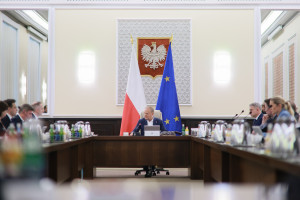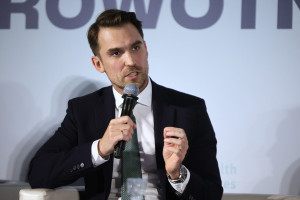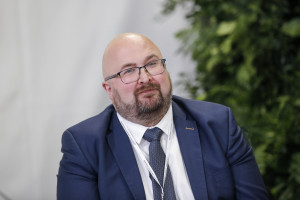Polish model of care for patients with NF. Neurofibromatoses are like a ticking time bomb

- On May 17th we celebrated World Neurofibromatosis Day
- It is a genetic disease that deforms the skin, damages organs and increases the risk of cancer.
- A lot of good things have happened recently; there is already talk about a Polish model of care for patients with neurofibromatosis.
- Dorota Korycińska, president of the Neurofibromatosis Poland Association, summarises in an interview with Rynek Zdrowia what has already been achieved and what needs are still unmet
Rynek Zdrowia: How many patients with neurofibromatosis live in Poland?
Dorota Korycińska : Unfortunately, we don't know. There is no registry in Poland. There is no such registry for rare diseases either. We rely on global statistics, which vary greatly. It is assumed that half of patients have mild symptoms or no symptoms at all, so they do not go to the doctor and do not know that they are genetically predisposed. But they have sick children. We have parents who find out that they are predisposed during their child's diagnosis. That is why the data on the number of patients is quite wide; it is between 15 and 30 thousand people in Poland.
What does everyday life look like for patients with neurofibromatosis?
This is a disease that is completely unpredictable. This is one of the most important features, because this unpredictability is emotionally difficult for patients and their families. Even if there is someone who has mild symptoms, they are not able to free themselves mentally from thinking full of fear about the future: will something happen to me? Will some symptom appear, and if so, when, how serious and how much will it affect my life? This is a disease that is particularly difficult in today's world, which requires a perfect aesthetic appearance, because the patient can appear numerous changes that cause problems with their acceptance, such as lumps, tumors, dysplasia, deformities. One of the fears therefore concerns not only the symptoms, but also the lack of social acceptance. Parents are afraid that if the disease in their children develops in a visual direction, they will be rejected. We have patients who are covered in lumps and are exposed to social ostracism. These are very unpleasant situations.
Of course, problems with appearance are one aspect of the disease. The clinical potential of neurofibromatoses can be much more serious. Our patients undergo many operations – oncological, surgical, orthopedic, sometimes they have chemotherapy, and in adulthood they are exposed to the development of malignant neoplastic diseases. Diagnosis of the disease in many cases means a permanent connection with the health care system.
But has anything changed for the benefit of patients?
A lot has changed in recent years, many positive things have happened.
Before 2020, patients searched for information about diseases on social media, used word of mouth and looked for specialists on their own. However, a disease that is unpredictable but also multi-symptom requires a very broad knowledge from the attending physician. That is why our diagnostic odyssey, parental, or adult patients was usually very long. The diagnostic odyssey of patients is also costly for the healthcare system, which is rarely remembered.
And what has changed?
A few years ago, considering both this diagnostic odyssey and the fact that we were not getting to specialists who had sufficient knowledge of this disease, we thought that we had to create our own system of care. The patient must know where there is a doctor who knows about this disease, who is able to provide comprehensive care for the patient, know about all possible potential symptoms, know when they can appear and know what to do about them, i.e. when to refer the patient to the right specialist.
For example, if a small child shows the beginnings of scoliosis, a doctor who is an expert in NF knows when to refer such a patient to an orthopedist, and preferably to one who has experience working with a patient with neurofibromatosis in their clinical practice. The concept is similar for other potential symptoms of NF. This is what coordinated care is all about. The coordinator is a doctor who knows the disease, observes the patient and, if necessary, refers them at the right time to another specialist who deals with individual symptoms of NF. And we managed to achieve this. Such coordinated care for NF has been operating since the beginning of 2020. At first, it was based on 4 centers in Poland, and now we have 6 of them.
We are lucky to have great doctors. The coordinated care program for NF was created by a doctor involved in the care of patients with neurofibromatosis, Dr. Marek Karwacki. It is also amazing that so many centers in Poland have decided to lean on our young patients and implement a coordinated care program for patients with neurofibromatosis and related rasopathies.
Is this enough?
This is the optimal number. It includes pediatric patients, all up to the age of 30. However, we have a problem with adults after the age of 30, because they fall out of the system as they enter adulthood.
Now we face another challenge, namely creating such centers and organizing a similar model of care for adults. Because this is needed until the end of life. Please keep your fingers crossed that we will succeed.
So we have comprehensive care for children, but not for adults.
What has changed in terms of treatment and access to therapy?
Here too, a lot has happened recently. Since the beginning of last year, Polish children have had access to treatment for specific inoperable tumors that can appear in the course of NF1- Plexiform neurofibromas. This is very important for patients, because as the name suggests, inoperable meant that nothing could be done about it. These tumors pose a huge therapeutic problem - they cannot be operated on, and their clinical harmfulness is enormous. They destroy nervous tissue, thus causing a whole cascade of health problems for the patient and his suffering. Access to this therapy for Polish children is also a huge hope for all patients, giving hope for further progress in science in neurofibromatoses.
Medicine has made a huge step forward, because there used to be no therapy at all. The association is almost 20 years old, and from the perspective of these two decades, we can see huge, positive changes in medicine, the beneficiaries of which are also patients with neurofibromas. Radiological and genetic tests have developed, and now we are talking about therapies!
I am also pleased that the group of pediatric patients in a very difficult health situation is well organized and has organized care. However, what we still need is the organization of such comprehensive and coordinated care for adults.
So we don't stand out much from other countries and patients don't have to seek help abroad?
Here it is probably the other way around. When it comes to coordinated care, I must admit that I was positively surprised after several European conferences, during which we talked about our experiences, about the establishment of centers for children. It turns out that our care organization is presented as an innovative solution. I even heard the term: "Polish model of care for neurofibromatoses". This does not happen often. We are in contact with other NF patient organizations from other countries and we get questions about what this care organization in Poland consists of. We arouse interest and this is very pleasant. I did not think that I would live to see such times when what the organization and doctors managed to create would be called a Polish model.
This is encouraging.
This gives us the wind in our wings that we cannot rest on our laurels, but we have to move on. We want every patient diagnosed as a child to have continuity of healthcare. If therapy appears along the way, that will be great, but the patient must be managed in a coordinated and comprehensive way. There must be a specialist who knows about his disease and who will know how the disease progresses at different stages of life, what to pay special attention to and whether there are - and what - treatment options for this patient.
We can have the best therapies in the world, but without good and rapid diagnosis and proper coordinated patient care we will not achieve optimal health benefits.
Copyrighted material - reprint rules are specified in the regulations .
rynekzdrowia











